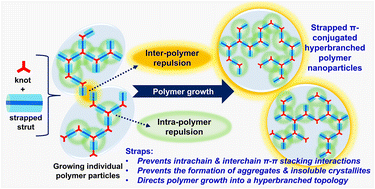π-Face strapped monomers enable self-stabilized hyperbranched π-conjugated polymer particles†
Abstract
π-Conjugated polymers that extend the π-conjugation in more than one dimension are highly sought after for various organic electronic and energy applications. However, the synthesis of solution processable higher dimensional π-conjugated materials is still at its infancy because of strong interchain π–π interactions. The conventional strategy of using linear alkyl pendant chains does not help overcome the strong interchain π–π interactions in higher dimensional π-conjugated materials as they do not directly mask the π-face of the repeat units. While the miniemulsion technique has been employed to generate hyperbranched π-conjugated polymer particles stabilized by surfactants, this approach does not address the molecular level challenges. We have proposed that π-face masking straps mask the π-face of the polymer backbone and therefore help to control π–π interchain interactions in higher dimensional π-conjugated materials at the molecular level. Herein, we have shown that when a strapped aryl dialdehyde monomer (A2) is reacted with a trifunctional 1,3,5-benzenetriamine (B3) using dynamic imine chemistry, a solution dispersible and processable hyperbranched polymer with a degree of branching of 0.46 is generated. Also, by varying the reaction conditions (catalyst, monomer concentration, and solvent), solution dispersible polymer particles of varying diameters ranging from 60 to 300 nm are generated. It is worth noting that despite having the suitable monomer architectures for the formation of ordered frameworks, a hyperbranched polymer is generated because the straps effectively hinder interlayer π–π stacking interactions, thereby preventing the formation of crystalline aggregates that are required for the growth of the former. Since straps stabilize the chains against π–π interactions at the molecular level, they will not only provide synthetic control over the architecture but also remove typical synthetic limitations associated with the miniemulsion technique including functional group intolerance and monomer miscibility.

- This article is part of the themed collection: Polymer Chemistry Emerging Investigators Series


 Please wait while we load your content...
Please wait while we load your content...